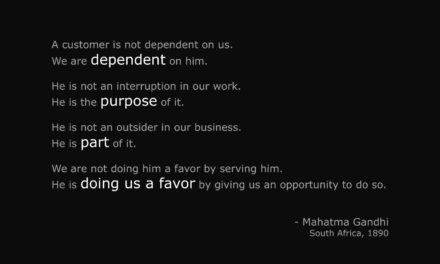This article first appeared in Commerce & Industry Magazine Vol 2 010 of Feb 2014
From the inception of performance contracting in the Public Sector in Kenya, the notion of Customer Service Charters has been discussed as a way to keep the service sector in check. By having the public aware of the commitment the institution is making, and the service levels to expect from the service provider, there has been a shift in customer expectations.
From the original discussions held in April 2005, the Public Service Reform and Development Secretariat, charged with the responsibility of developing structures for performance contracting, defined the desired customer service charter in article 51 of their blueprint for sector reforms as “A Service Charter is a Public Statement or ‘Contract’ that defines and declares what an organization is, the organization’s mandate, the services the organization provides, details of any user charges, what standards of services should be expected by the consumers and how the consumers of the service may seek redress if they are dissatisfied with the service(s) provided”. They went further to summarize Service Charters as “providing commitments to provide a certain type, volume and quality of service as well as stating client obligations, providing greater client choice in service delivery and detailing complaints and redress mechanisms”.
This more than adequately captures the essence and importance of Customer Service Charters and underscores the rationale for every institution both in the private and public sector to have one. The private sector in principle seems to have caught on and have these charters under several different titles including ‘Service Delivery Statements’ ‘Customer Service Promises’ or ‘Customer Service Expectations’. Whatever fancy name is applied, the definition of the Customer Service Charter as outlined in the Public Sector arena, by far and large articulately enumerates in detail the specific grounding tenets that should be applied.
Pressing the fast forward button to current times, we find that with the present government of the day, the Ministry of Devolution and Planning that has a specific unit handling performance contracting, demands performance against targets set out in the individual Ministries, Departments and Agencies’ (MDAs) Customer Service Charters. This extends to Parastatals and all public service commissions and boards, and forms a significant subject of discussion during the end of period appraisals. So serious is this matter that the charters are on display, well framed and in public sight on the walls of all public institutions.
The situation so far sounds very nice, well put together and all set right? What with service contracts in place, appropriate well thought out information captured on charters, service delivery promises and customer commitments dotting the public sector, what more could a country need? Well, the critical question to ask at this point is if indeed this is a workable system of operation or just a fad that seems to have taken the country by storm.
In as much as the proverbial writing may be on the wall, and indeed sitting pretty, the crunch point remains if this writing translates into actualization. The fact that public sector organizations have thought through their individual brand promises and the service delivery standards they would like to commit to their customers, counts for much. The fact that they have gone a step ahead and documented these, proudly hung them up on their walls and posted them on their websites is indeed a huge milestone. The next step would then be to have systems and structures in place to deliver on these promises and to encourage customers to agitate for service delivery.
What would catapult a Customer Service Charter from being a decorative ‘Wall Hanging’ to being a useful communication tool for excellent customer service delivery? The secret lies in three simple points.
The first and most important strategy is to communicate your customer service charter consistently. In addition to prominently displaying it, the leadership of the institution must ensure staff at all levels are aware of the promises made in the charter. The internal customers should be the first advocates and proponents of the charter. The charter should not be seen as something the ‘leadership’ have put up or something routine that is hung on the wall in the same format as the obligatory presidential portraits or organization signage, but as a heartfelt promise. This communication should be consistent and repetitive and should form the opening and closing agenda during meetings, at staff induction and appraisals and at every opportunity that presents itself for reinforcement. The more internal staff hear about and understand the rationale and benefit, the more likely they are to own the promise and strive to deliver on it.
The second secret to Customer Service Charter success is to be in constant touch with the stakeholders for whom the charter was developed – the customers. By seeking customer feedback continuously, and conducting a comparative analysis of the promises made versus the feedback received, the institution will have a good platform to make the necessary adjustments to work towards achievement of the charter declarations. Customer feedback should be sought through both formal and informal means to assess service delivery performance. The people to whom the promises are made are the best test to weigh if the promises are being delivered as per expectation. Listening to your customers and implementing relevant changes is a strategy that has proven over time to yield consistently exceptional results.
The third strategy towards successful Customer Service Charter implementation is to continuously measure progress. As wisdom dictates – ‘things that cannot be measured do not exist’. In tandem with this, each institution should query their charter if it already exists or build in if developing a new charter, instituted measurement parameters per promise to assess performance. These parameters should be simple, clear and concise, enabling performance analysis to yield straight forward results. The assessment should be conducted regularly and persons in charge of conducting this exercise should derive results that are easily communicated across to all staff, to understand the impact of their activities. The results should also be clear enough to enable and influence strategic decision making.
It would add value to conduct a country wide audit of the Customer Service Charters in place and the internal and external customer assessment on performance. This would then inform the specific institution as well as provide a good base for similar institutions seeking to develop charters, to learn from the experiences of those who have gone before. And if the results of these audits would be published, it would enable the wider public from both the formal and informal sector to borrow the positive aspects and be cognizant of the areas for improvement to inform their specific situations.
Sylvester Odhiambo Obong’o in his treatise ‘ Implementation of performance contracting in Kenya’ very rightly postulates that Kenya introduced performance contracting not only improve service delivery but also to refocus the mind set of public service away from a culture of inward looking towards a culture of business as focused on customer and results. Indeed customer service charters are a useful tool towards delivery of exceptional customer service. It is however incumbent on the charter developers to go beyond development and invest in implementation for success.
·








